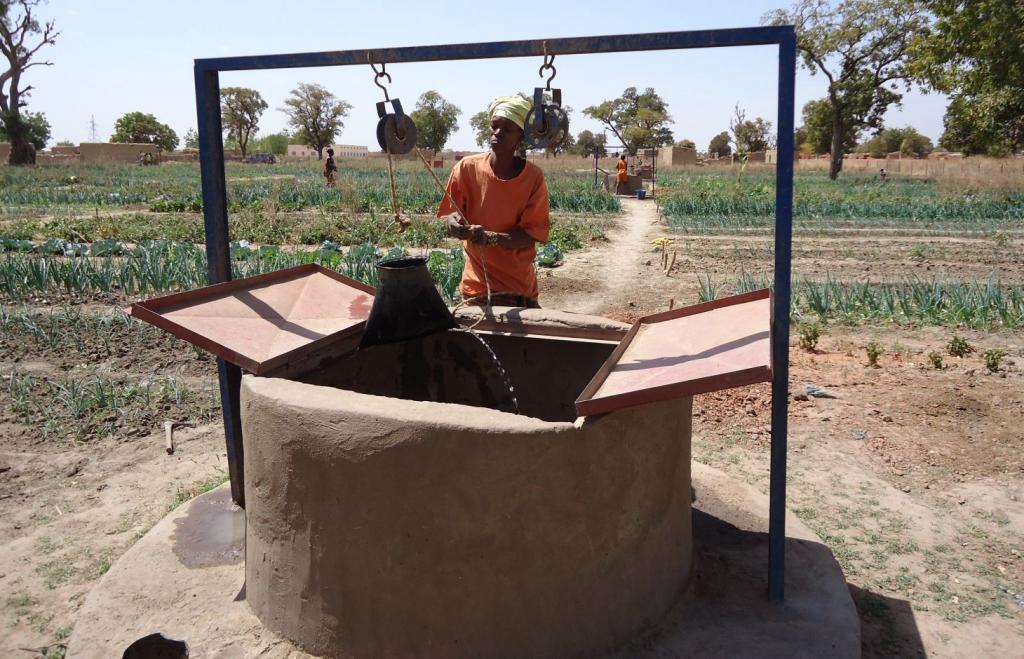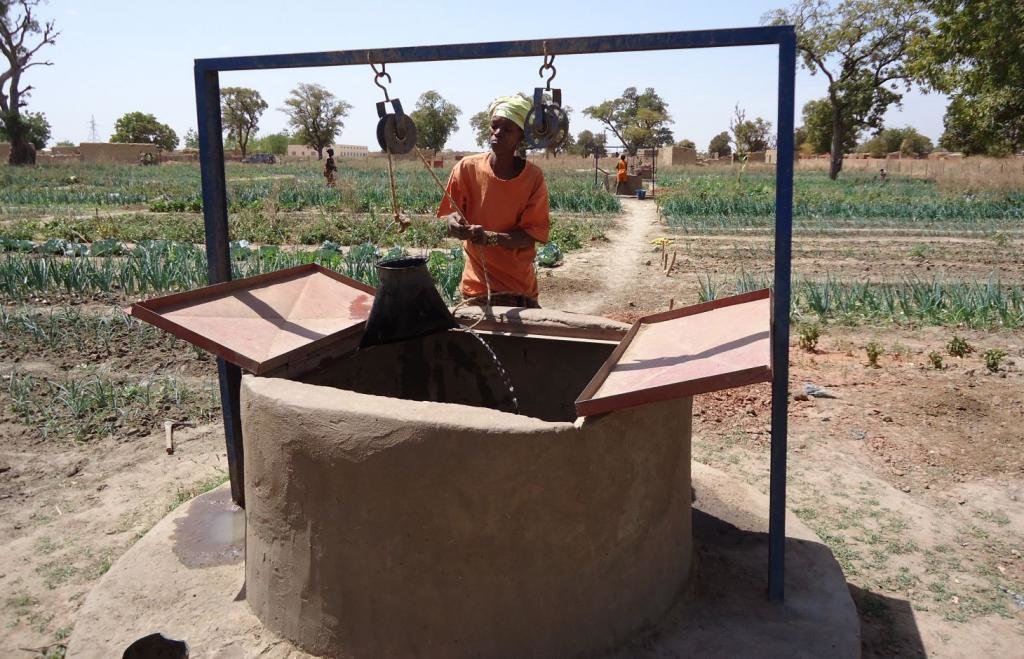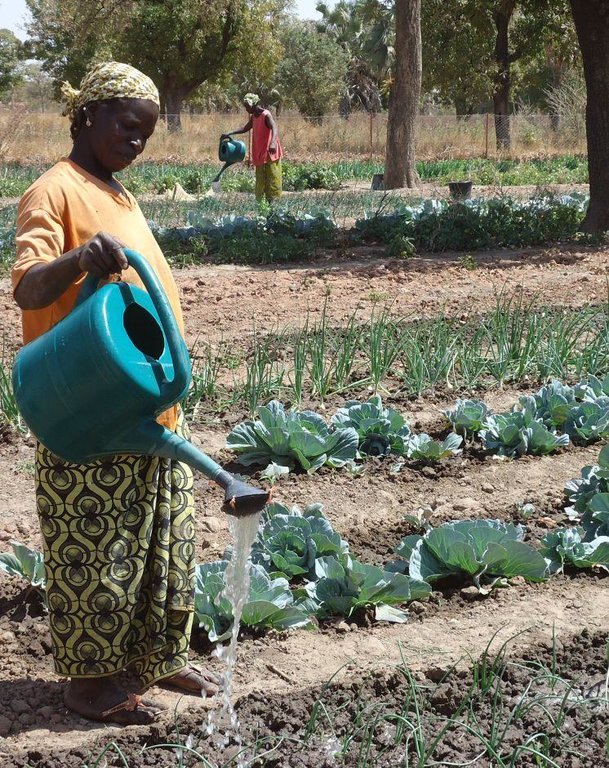Diversifying women’s income streams through market gardening [Mali]
- Creation:
- Update:
- Compiler: Dieter Nill
- Editor: –
- Reviewer: Laura Ebneter
Diversification des revenus des femmes par des jardins maraichers
approaches_2501 - Mali
View sections
Expand all Collapse all1. General information
1.2 Contact details of resource persons and institutions involved in the assessment and documentation of the Approach
SLM specialist:
Diassana Joseph
jd@bornefondenmali.org
BØRNEfonden - Children & Youth Foundation
Mali
SLM specialist:
Coulibaly Sourakata
sc@bornefondenmali.org
BØRNEfonden
Mali
Name of the institution(s) which facilitated the documentation/ evaluation of the Approach (if relevant)
Deutsche Gesellschaft für Internationale Zusammenarbeit (GIZ) - GermanyName of the institution(s) which facilitated the documentation/ evaluation of the Approach (if relevant)
BØRNEfonden - Children & Youth Foundation - Denmark1.3 Conditions regarding the use of data documented through WOCAT
When were the data compiled (in the field)?
01/07/2012
The compiler and key resource person(s) accept the conditions regarding the use of data documented through WOCAT:
Yes
2. Description of the SLM Approach
2.1 Short description of the Approach
Establishing vegetable plots for women enables them to increase their incomes and improve their health by increasing and diversifying agricultural production and improving the nutritional quality of their food.
2.2 Detailed description of the Approach
Detailed description of the Approach:
Market gardening also enables women to set up savings funds through their associations, builds their capacity to organise and manage market gardens and improves their cultivation techniques. Market gardens set up by women’s associations are usually sited adjacent to lowland areas or rivers so as to facilitate access to water, which is extracted from wells. The areas of these market gardens range from 0.5 to 1 hectare depending on the size of the association and the opportunities for selling produce locally. Allotment sizes range from 80 to 120 square metres per woman. The number of growers per market garden is no greater than 70 women per hectare and 35 women per half-hectare. Women receive a grant in the form of equipment and agricultural inputs. The wells created for the market gardens are 1.4 metres in diameter, have 60-centimetre-high well heads and 30-centimetre-wide footpaths from which to water crops. Eight wells are installed per hectare across the site.
1)A women’s association puts forward its needs, 2)The BØRNEfonden Development Unit carries out a scoping study, 3) Women are organised into an association, 4) The women contribute their share of the costs (10% of the investment costs), 5) A site with guaranteed access to water (i.e. close to the water table) is enclosed, 6)The market garden’s wells are dug, 7)Financial support is provided during the first growing season to pay for equipment and agricultural inputs, 8)The association undertakes a self-assessment and draws up a training plan, 9)BØRNEfonden’s Development Units provide time-limited advisory support, the duration of which depends on capacity-building needs and ranges from three to five years per village. A four-month period of advisory support is allotted to service providers (technical services and consultancies). In order to achieve the best outcomes, it is important to define rules and requirements upfront. These requirements are met by developing an internal control system and nominating an internal control committee. The beneficiaries draw up the management procedures for their site, setting out how it is accessed and how women farmers are selected through internal regulation. Selected committee members receive training in organising and managing the site. Management tools are put in place for this purpose. A plan for the growing season is drawn up with women growers, which means needs can also be evaluated. BØRNEfonden provides the funding. The production costs of sold crops are evaluated and the required funds are then reimbursed by growers through the payment of subscription fees, using a payment system that they have collectively defined. Subscriptions paid by the women are safely set aside in the savings fund created by the association in order to ensure repayments can be made on the equipment paid for by BØRNEfonden.
The women’s association makes a suitable site available and prepares the soil (clearing, grubbing and ploughing). It also contributes a 10% share of the investment and opens a bank account to provide for the repayment of the investment. BØRNEfonden undertakes site development works (laying out, well digging, fencing), carries out crop planning, buys in equipment and agricultural inputs, installs nurseries, establishes and allocates plots, prepares seedbeds, transplants seedlings, and deploys plant health products and fertilisers. BØRNEfonden supports scheme farmers with the growing, harvesting and sale of produce. Local authorities sign the service contracts established between BØRNEfonden and the private contractors hired when the market garden activities got underway (well digging and site fencing). Government and consultancy technical services are involved in performing studies, delivering training in cultivation techniques and monitoring vegetable growing plots.
2.3 Photos of the Approach
2.5 Country/ region/ locations where the Approach has been applied
Country:
Mali
Region/ State/ Province:
Mali
Further specification of location:
Yanfolila, Bougouni and Dioïla in the regions of Koulikoro and Sikasso
2.6 Dates of initiation and termination of the Approach
Indicate year of initiation:
2008
2.8 Main aims/ objectives of the Approach
The Approach focused mainly on SLM with other activities
To increase women's incomes and improve their health by increasing and diversifying agricultural production and improving the nutritional quality of their food. Market gardening also enables women to set up savings funds through their associations, builds their capacity to organise and manage market gardens and improves their cultivation techniques.
The SLM Approach addressed the following problems: lack of work, money and food for women; negative ecological impact due to traditional practices such as deforestation or gold mining;
2.9 Conditions enabling or hindering implementation of the Technology/ Technologies applied under the Approach
availability/ access to financial resources and services
- hindering
lack of money
Treatment through the SLM Approach: BØRNEfonden provides the funding. The production costs of sold crops are evaluated and the required funds are then reimbursed by growers through the payment of subscription fees, using a payment system that they have collectively defined. Subscriptions paid by the women are safely set aside in the savings fund created by the association in order to ensure repayments can be made on the equipment paid for by BØRNEfonden.
institutional setting
- hindering
Treatment through the SLM Approach: BØRNEfonden supports scheme farmers with the growing, harvesting and sale of produce.
knowledge about SLM, access to technical support
- hindering
Treatment through the SLM Approach: BØRNEfonden undertakes site development works (laying out, well digging, fencing), carries out crop planning, buys in equipment and agricultural inputs, installs nurseries, establishes and allocates plots, prepares seedbeds, transplants seedlings, and deploys plant health products and fertilisers.
3. Participation and roles of stakeholders involved
3.1 Stakeholders involved in the Approach and their roles
- local land users/ local communities
- SLM specialists/ agricultural advisers
- NGO
BØRNEfonden
- national government (planners, decision-makers)
Government and consultancy technical services are involved in performing studies, delivering training in cultivation techniques and monitoring vegetable growing plots.
3.2 Involvement of local land users/ local communities in the different phases of the Approach
| Involvement of local land users/ local communities | Specify who was involved and describe activities | |
|---|---|---|
| initiation/ motivation | passive | |
| planning | interactive | |
| implementation | interactive | |
| monitoring/ evaluation | passive | |
| Research | passive |
3.4 Decision-making on the selection of SLM Technology/ Technologies
Specify who decided on the selection of the Technology/ Technologies to be implemented:
- mainly land users, supported by SLM specialists
Explain:
Decisions on the method of implementing the SLM Technology were made by mainly by land users supported by SLM specialists
4. Technical support, capacity building, and knowledge management
4.1 Capacity building/ training
Was training provided to land users/ other stakeholders?
Yes
Specify who was trained:
- land users
Form of training:
- on-the-job
- farmer-to-farmer
- public meetings
- courses
4.2 Advisory service
Do land users have access to an advisory service?
Yes
Specify whether advisory service is provided:
- on land users' fields
Describe/ comments:
Advisory service is quite adequate to ensure the continuation of land conservation activities
4.3 Institution strengthening (organizational development)
Have institutions been established or strengthened through the Approach?
- yes, greatly
Specify the level(s) at which institutions have been strengthened or established:
- local
Specify type of support:
- financial
- capacity building/ training
- equipment
4.4 Monitoring and evaluation
Is monitoring and evaluation part of the Approach?
Yes
Comments:
Bio-physical aspects were ad hoc monitored by project staff through observations
Technical aspects were ad hoc monitored by project staff through observations
Socio-cultural aspects were ad hoc monitored by project staff through observations
Economic / production aspects were regular monitored by project staff through measurements
Area treated aspects were regular monitored by project staff through measurements
Land users involved aspects were regular monitored by project staff through measurements
Management of Approach aspects were ad hoc monitored by project staff through observations
There were no changes in the Approach as a result of monitoring and evaluation
There were no changes in the Technology as a result of monitoring and evaluation
4.5 Research
Was research part of the Approach?
Yes
Specify topics:
- sociology
- economics / marketing
- ecology
- technology
5. Financing and external material support
5.1 Annual budget for the SLM component of the Approach
If precise annual budget is not known, indicate range:
- 2,000-10,000
Comments (e.g. main sources of funding/ major donors):
Approach costs were met by the following donors: international non-government (BØRNEfonden): 90.0%; local community / land user(s): 10.0%
5.2 Financial/ material support provided to land users
Did land users receive financial/ material support for implementing the Technology/ Technologies?
Yes
5.3 Subsidies for specific inputs (including labour)
- equipment
| Specify which inputs were subsidised | To which extent | Specify subsidies |
|---|---|---|
| machinery | fully financed | |
| tools | fully financed | |
- agricultural
| Specify which inputs were subsidised | To which extent | Specify subsidies |
|---|---|---|
| seeds | fully financed | |
| fertilizers | fully financed | |
If labour by land users was a substantial input, was it:
- voluntary
6. Impact analysis and concluding statements
6.1 Impacts of the Approach
Did the Approach help land users to implement and maintain SLM Technologies?
- No
- Yes, little
- Yes, moderately
- Yes, greatly
This new occupation deters women from taking up traditional practices that involve deforestation or environmental damage (gold mining). In light of these very encouraging levels of income, women producers will be more interested in sustaining and continuing their market gardening activities.
Did the Approach empower socially and economically disadvantaged groups?
- No
- Yes, little
- Yes, moderately
- Yes, greatly
focus on women
Did other land users / projects adopt the Approach?
- No
- Yes, little
- Yes, moderately
- Yes, greatly
The activity has been operating since 2008 with increasing success. Since 2008, 21 development units have supported the installation and management of 57 market gardens, 14 nutrition gardens (based on strip-farmed food crops and jujubes), and 286 wells across a total area of 32.3 hectares. The total number of women farmers involved stands at 2,752. Schemes were installed in 27 communes across the three circles of Yanfolila, Bougouni and Dioïla in the regions of Koulikoro and Sikasso. 26 villages benefited from the installation of market gardens in 12 rural communes in the Koulikoro Region. 31 villages benefited from the installation of market gardens in 15 communes in the Sikasso Region.
Did the Approach lead to improved livelihoods / human well-being?
- No
- Yes, little
- Yes, moderately
- Yes, greatly
Dietary diversification resulting from the communities’ (and particularly children’s) access to vegetables and the introduction of certain crops like potato and French beans. The consumption of vegetables and having the financial means to buy different kinds of foods improve the nutritional quality of diets.
Did the Approach help to alleviate poverty?
- No
- Yes, little
- Yes, moderately
- Yes, greatly
Some of these women have already been able to capitalise on their incomes by buying livestock (cows, small ruminants). Ensuring women are well organised across the market garden site, promoting good management and increasing the purchasing power of producers are equally important factors in achieving sustainability.
6.2 Main motivation of land users to implement SLM
- increased production
- increased profit(ability), improved cost-benefit-ratio
- payments/ subsidies
6.3 Sustainability of Approach activities
Can the land users sustain what has been implemented through the Approach (without external support)?
- yes
If yes, describe how:
The women are now able to reproduce the same approaches. With BØRNEfonden’s support, they have the funds to buy good quality agricultural inputs, which guarantees good production. The savings held in their bank accounts help with equipment repayments.
6.4 Strengths/ advantages of the Approach
| Strengths/ advantages/ opportunities in the compiler’s or other key resource person’s view |
|---|
| Environmental impacts: a sharp drop in the overcutting of trees to make charcoal, and a sharp drop in traditional gold mining activities and their negative environmental impacts |
| The consumption of vegetables and having the financial means to buy different kinds of foods improve the nutritional quality of diets. |
| Dietary diversification resulting from the communities’ (and particularly children’s) access to vegetables and the introduction of certain crops like potato and French beans. |
| Women’s takings from their vegetable crops range from 35,000 to 125,000 CFA francs, depending on the production scenario and location. We have recorded sales of between 7.5 and 8 tonnes of potato resulting from 25 crates of seed potato. Sold at a rate of 225 CFA francs per kilogram, this generates a total of between 1,687,500 to 1,800,000 CFA francs. |
|
Strengthening the capacities of women vegetable growers ensures the sustainability of this good practice. Indeed, the women are now able to reproduce the same approaches. With BØRNEfonden’s support, they have the funds to buy good quality agricultural inputs, which guarantees good production. The savings held in their bank accounts help with equipment repayments. |
| Market gardening is now being carried out at times when women would traditionally have been without work and lacking money and food. This new occupation deters women from taking up traditional practices that involve deforestation or environmental damage (gold mining). In light of these very encouraging levels of income, women producers will be more interested in sustaining and continuing their market gardening activities. Some of these women have already been able to capitalise on their incomes by buying livestock (cows, small ruminants). Ensuring women are well organised across the market garden site, promoting good management and increasing the purchasing power of producers are equally important factors in achieving sustainability. |
6.5 Weaknesses/ disadvantages of the Approach and ways of overcoming them
| Weaknesses/ disadvantages/ risks in the compiler’s or other key resource person’s view | How can they be overcome? |
|---|---|
| The constraints to report relate to: low-rainfall periods (drying up of wells), pests attacking crops, and problems selling crops (poor sales, low sale prices). |
7. References and links
7.1 Methods/ sources of information
- field visits, field surveys
- interviews with land users
7.2 References to available publications
Title, author, year, ISBN:
Manual of Good Practices in Small Scale Irrigation in the Sahel. Experiences from Mali. Published by GIZ in 2014.
Available from where? Costs?
http://star-www.giz.de/starweb/giz/pub/servlet.starweb
Title, author, year, ISBN:
Procedures and technical specifications for market garden schemes, BØRNEfonden – Mali
Links and modules
Expand all Collapse allLinks
No links
Modules
No modules




